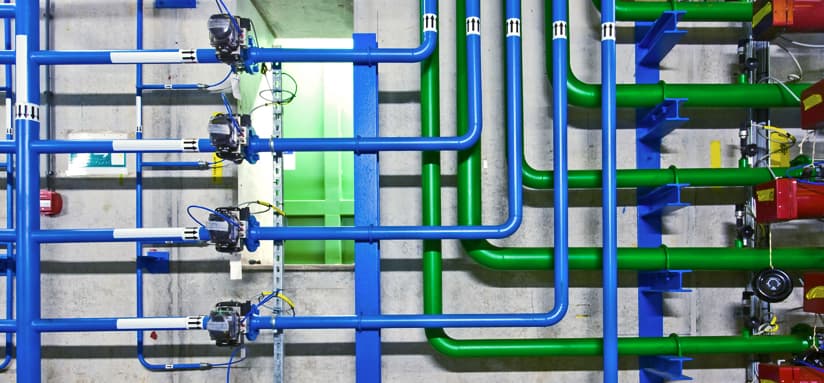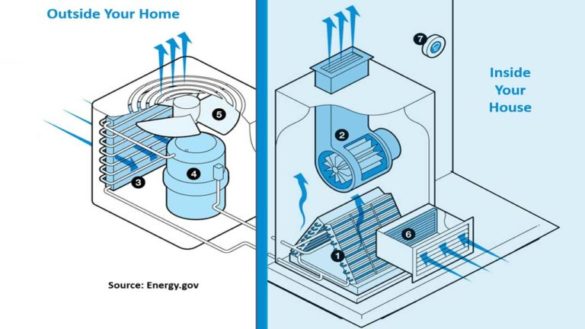Just about every person maintains their own unique conception with regards to Anatomy of a House: Understanding the Components.

Recognizing how your home's pipes system works is essential for every single homeowner. From supplying clean water for alcohol consumption, cooking, and showering to safely eliminating wastewater, a well-maintained pipes system is essential for your family members's health and wellness and comfort. In this detailed guide, we'll check out the elaborate network that comprises your home's pipes and deal tips on upkeep, upgrades, and taking care of typical issues.
Introduction
Your home's pipes system is more than simply a network of pipelines; it's a complex system that ensures you have accessibility to tidy water and effective wastewater removal. Understanding its components and just how they work together can aid you prevent expensive repair services and make certain everything runs smoothly.
Basic Elements of a Plumbing System
Pipes and Tubes
At the heart of your plumbing system are the pipelines and tubing that bring water throughout your home. These can be constructed from various products such as copper, PVC, or PEX, each with its advantages in regards to longevity and cost-effectiveness.
Components: Sinks, Toilets, Showers, and so on.
Fixtures like sinks, bathrooms, showers, and bath tubs are where water is used in your home. Comprehending exactly how these fixtures connect to the pipes system helps in identifying troubles and planning upgrades.
Valves and Shut-off Points
Shutoffs regulate the flow of water in your pipes system. Shut-off valves are critical throughout emergencies or when you need to make fixings, allowing you to isolate parts of the system without interrupting water flow to the whole house.
Water System System
Key Water Line
The major water line connects your home to the local water system or a private well. It's where water enters your home and is distributed to different fixtures.
Water Meter and Stress Regulatory Authority
The water meter actions your water use, while a pressure regulatory authority makes sure that water moves at a safe pressure throughout your home's pipes system, protecting against damages to pipes and fixtures.
Cold Water vs. Hot Water Lines
Recognizing the difference in between cold water lines, which provide water directly from the primary, and warm water lines, which carry heated water from the water heater, assists in fixing and preparing for upgrades.
Drainage System
Drain Pipes Piping and Traps
Drain pipelines carry wastewater far from sinks, showers, and toilets to the sewer or sewage-disposal tank. Traps stop drain gases from entering your home and also trap particles that could cause clogs.
Ventilation Pipes
Ventilation pipelines permit air right into the water drainage system, preventing suction that could slow drain and trigger traps to empty. Proper air flow is crucial for keeping the honesty of your plumbing system.
Importance of Correct Water Drainage
Ensuring correct drain stops back-ups and water damage. On a regular basis cleansing drains pipes and maintaining traps can prevent costly repair work and extend the life of your pipes system.
Water Heating System
Types of Hot Water Heater
Hot water heater can be tankless or typical tank-style. Tankless heating units warm water on demand, while tanks store warmed water for instant usage.
Exactly How Water Heaters Link to the Plumbing System
Understanding how hot water heater attach to both the cold water supply and warm water distribution lines helps in diagnosing issues like not enough warm water or leaks.
Maintenance Tips for Water Heaters
Routinely flushing your hot water heater to get rid of debris, checking the temperature setups, and checking for leaks can expand its life-span and enhance energy performance.
Usual Plumbing Issues
Leakages and Their Reasons
Leakages can occur as a result of aging pipes, loosened installations, or high water pressure. Addressing leakages quickly prevents water damages and mold growth.
Obstructions and Obstructions
Clogs in drains pipes and commodes are frequently triggered by flushing non-flushable things or an accumulation of grease and hair. Making use of drain displays and being mindful of what goes down your drains pipes can avoid obstructions.
Indications of Pipes Issues to Expect
Low water pressure, slow-moving drains, foul odors, or unusually high water expenses are signs of possible plumbing troubles that ought to be resolved quickly.
Pipes Maintenance Tips
Normal Evaluations and Checks
Set up yearly plumbing inspections to catch concerns early. Search for indicators of leaks, deterioration, or mineral buildup in taps and showerheads.
Do It Yourself Maintenance Tasks
Straightforward tasks like cleansing faucet aerators, checking for commode leakages using dye tablets, or shielding exposed pipelines in chilly climates can stop major pipes problems.
When to Call a Specialist Plumbing Technician
Know when a plumbing concern needs specialist competence. Trying intricate repair services without correct expertise can result in even more damage and higher repair service prices.
Updating Your Plumbing System
Factors for Upgrading
Upgrading to water-efficient components or replacing old pipes can boost water top quality, lower water bills, and enhance the worth of your home.
Modern Pipes Technologies and Their Benefits
Explore innovations like smart leak detectors, water-saving toilets, and energy-efficient hot water heater that can conserve cash and reduce environmental effect.
Expense Factors To Consider and ROI
Determine the in advance prices versus long-lasting financial savings when considering pipes upgrades. Many upgrades pay for themselves with decreased energy bills and fewer repair work.
Environmental Influence and Preservation
Water-Saving Components and Appliances
Setting up low-flow faucets, showerheads, and bathrooms can substantially lower water usage without compromising efficiency.
Tips for Lowering Water Usage
Basic routines like taking care of leakages without delay, taking shorter showers, and running full tons of laundry and dishes can conserve water and lower your utility costs.
Eco-Friendly Pipes Options
Take into consideration sustainable plumbing materials like bamboo for floor covering, which is durable and environmentally friendly, or recycled glass for countertops.
Emergency Preparedness
Steps to Take Throughout a Pipes Emergency situation
Know where your shut-off valves lie and just how to turn off the supply of water in case of a burst pipe or major leak.
Significance of Having Emergency Contacts Useful
Keep contact information for local plumbers or emergency solutions easily available for quick reaction during a plumbing dilemma.
DIY Emergency Fixes (When Applicable).
Short-term solutions like making use of air duct tape to spot a leaking pipe or positioning a container under a leaking tap can lessen damage until a professional plumbing shows up.
Final thought.
Understanding the anatomy of your home's pipes system equips you to preserve it successfully, saving money and time on repair services. By complying with regular upkeep regimens and remaining notified about modern pipes modern technologies, you can ensure your pipes system operates efficiently for several years ahead.
Understanding Your Home Plumbing System: A Comprehensive Guide
Plumbing System: The Lifeline of Your Home
At its core, the plumbing system is designed to perform two primary functions: bring fresh water into your home and remove wastewater. The system is a network of pipes, fixtures, and other components that transport water and sewage. Residential plumbing systems include potable water supply lines, drain-waste-vent (DWV) systems, and various plumbing fixtures that make water use in daily tasks possible.
Key Components:
Water Supply: This part of your plumbing system brings municipal water into your home, passing through the main water supply line. It s responsible for supplying all water needs, from drinking to bathing.
Drainage System: It carries waste and water away from your home to the sewer or septic system. This system includes all the piping within your home that leads to external sewage or septic systems.
Vent System: An essential yet often overlooked component, the vent system allows sewer gases to escape and lets air into the drainpipes, ensuring water and waste move correctly through the system.
Fixture: More Than Just Taps and Toilets
Plumbing fixtures are the most interactive parts of the plumbing system, including faucets, showers, toilets, and sinks. Each fixture is connected to the plumbing system and plays a role in either the delivery of freshwater or the disposal of waste and wastewater.
Types of Fixtures:
Faucets and Sinks: Used for washing hands, dishes, and other daily water needs.
Toilets: Dispose of human waste through the sewage system.
Bathtubs and Showers: Provide bathing facilities, requiring both hot and cold water supply.
Water Supply: The Source of Life
The water supply system is a critical component, ensuring that potable water is available throughout your home for various uses, including drinking, cooking, and cleaning. This system consists of pipes that distribute water to different parts of the house, controlled by valves to regulate the water flow.
Types of Plumbing: Materials and Methods
Various types of plumbing systems and materials are used in residential settings, each with its advantages and applications. From copper and PVC pipes for water supply to cast iron and ABS for drainage, the choice of materials can impact the longevity and efficiency of your plumbing system.
https://intownplumbingtx.com/articles/home-plumbing-system-guide/

Understanding Your Home Plumbing System: A Comprehensive Guide
Plumbing System: The Lifeline of Your Home
At its core, the plumbing system is designed to perform two primary functions: bring fresh water into your home and remove wastewater. The system is a network of pipes, fixtures, and other components that transport water and sewage. Residential plumbing systems include potable water supply lines, drain-waste-vent (DWV) systems, and various plumbing fixtures that make water use in daily tasks possible.
Key Components:
Water Supply: This part of your plumbing system brings municipal water into your home, passing through the main water supply line. It s responsible for supplying all water needs, from drinking to bathing.
Drainage System: It carries waste and water away from your home to the sewer or septic system. This system includes all the piping within your home that leads to external sewage or septic systems.
Vent System: An essential yet often overlooked component, the vent system allows sewer gases to escape and lets air into the drainpipes, ensuring water and waste move correctly through the system.
Fixture: More Than Just Taps and Toilets
Plumbing fixtures are the most interactive parts of the plumbing system, including faucets, showers, toilets, and sinks. Each fixture is connected to the plumbing system and plays a role in either the delivery of freshwater or the disposal of waste and wastewater.
Types of Fixtures:
Water Supply: The Source of Life
The water supply system is a critical component, ensuring that potable water is available throughout your home for various uses, including drinking, cooking, and cleaning. This system consists of pipes that distribute water to different parts of the house, controlled by valves to regulate the water flow.
Types of Plumbing: Materials and Methods
Various types of plumbing systems and materials are used in residential settings, each with its advantages and applications. From copper and PVC pipes for water supply to cast iron and ABS for drainage, the choice of materials can impact the longevity and efficiency of your plumbing system.
https://intownplumbingtx.com/articles/home-plumbing-system-guide/
I hope you enjoyed our topic about Understanding Your Home's Plumbing Anatomy. Thanks a lot for spending some time to browse our post. Liked our article? Please quickly share it. Let other people discover it. Many thanks for taking the time to read it.
Here